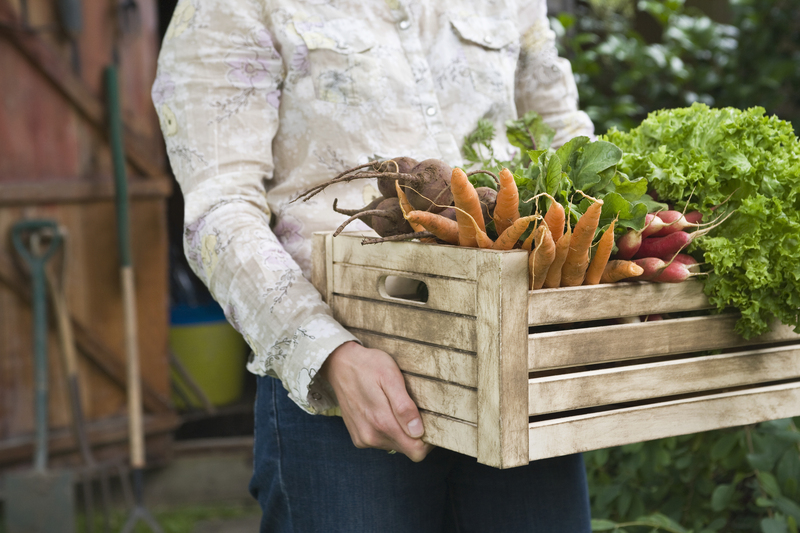Planting the Seeds for Climate Change Solutions
Posted on 16/06/2025
Planting the Seeds for Climate Change Solutions
Climate change stands as one of the defining challenges of the 21st century. From rising global temperatures to extreme storms and shifting ecosystems, its impacts reach every corner of the earth. Yet, planting the seeds for climate change solutions is not only a matter of planning; it is a call to urgent action. Humanity has the tools, resources, and ingenuity to address and mitigate climate change, but it requires coordinated effort, innovation, and a commitment to sustainability.
Understanding Climate Change: The Urgency for Solutions
Before exploring ways to plant the seeds for effective climate action, it is essential to grasp the scope of the challenge. Climate change primarily results from the buildup of greenhouse gases such as carbon dioxide (CO2), methane, and nitrous oxide--emitted from fossil fuels, deforestation, and industrial activities--trapping heat in the earth's atmosphere.
- Global temperatures have already risen about 1.1?C since pre-industrial times.
- Ocean levels are rising, threatening coastal communities worldwide.
- Extreme weather events, including droughts, floods, and wildfires, are becoming more common and intense.
Addressing these challenges requires us to plant the seeds for climate change solutions that are adaptive, resilient, and impactful.

The Importance of "Planting Seeds" for Change
The phrase planting the seeds evokes the imagery of nurturing new ideas and initiatives that can grow and mature over time. For climate change, these seeds can be literal--such as trees and vegetation--or metaphorical, such as innovative policies, technologies, and educational efforts. Their cultivation is a fundamental step toward securing our planet's future.
Why Focus on Planting the Seeds for Climate Change Solutions?
- Long-term impact: Early investments in climate solutions grow exponentially over time.
- Building resilience: Initiatives started today prepare societies for future climate stresses.
- Empowering communities: Grassroots projects enable local ownership and innovation.
Every seed planted today, whether an idea, a policy, or an actual plant, helps construct a foundation for a more sustainable tomorrow.
Actionable Seeds: Initiatives for Climate Change Solutions
There are numerous strategies for seeding change, some rooted in the natural world, others in our society and technology. Let's explore key ways individuals, communities, and governments can plant effective seeds for climate action.
1. Reforestation and Afforestation
Nothing embodies planting seeds for climate solutions more literally than planting trees. Forests serve as the planet's lungs--absorbing carbon dioxide and releasing oxygen, while also offering habitat for biodiversity.
- Reforestation: Restoring forests that have been degraded or destroyed through natural or human causes.
- Afforestation: Creating new forests in areas that haven't been forested in recent history.
According to the Intergovernmental Panel on Climate Change (IPCC), restoring and expanding forests could sequester billions of tons of carbon annually, making tree planting one of the most accessible and potent tools in the fight against global warming.
2. Regenerative Agriculture
Modern agriculture often emits greenhouse gases, but regenerative practices can reverse this trend, transforming farmlands into carbon sinks. Regenerative agriculture includes techniques such as:
- Cropland cover cropping and crop rotation
- Reducing or eliminating tillage
- Integrating livestock in sustainable ways
- Utilizing compost and organic matter
By improving soil health and increasing carbon storage, farmers directly plant the seeds for healthy ecosystems and reduced atmospheric carbon.
3. Urban Greening and Nature-Based Solutions
Urban landscapes are uniquely vulnerable to climate extremes, such as heat waves and flooding. Nature-based solutions like rooftop gardens, green belts, and urban forests can:
- Cool urban temperatures by up to several degrees Celsius
- Support biodiversity in city environments
- Absorb rainwater and help manage stormwater
- Improve air quality and offer recreational spaces
Implementing these solutions not only boosts urban resilience but also engages city dwellers in environmental stewardship.
Technological Seeds for a Greener Future
While natural approaches are essential, confronting climate change also requires modern technology. Here are some promising "seeds" for climate innovation:
1. Clean Energy Revolution
Transitioning away from fossil fuels to renewables like solar, wind, hydroelectric, and geothermal is critical. Key steps for planting the seeds for a clean energy future include:
- Expanding renewable energy infrastructure
- Innovating better energy storage technologies
- Developing smart grids to manage energy use efficiently
- Incentivizing businesses and individuals to adopt renewables
According to the International Energy Agency (IEA), wind and solar are now the cheapest new sources of electricity in many regions, making their widespread adoption both environmentally necessary and economically wise.
2. Electrification of Transport
The transportation sector is responsible for about 15% of global greenhouse gas emissions. Electric vehicles (EVs), powered by clean energy, dramatically reduce these emissions. Additional transport solutions include:
- Expanding mass transit and cycling infrastructure
- Developing green hydrogen for shipping and aviation
- Promoting car-sharing and telecommuting options
3. Building Efficiency and Sustainable Architecture
Buildings account for nearly 40% of global energy use. Upgrading insulation, using sustainable materials, and integrating passive solar design and smart technology all contribute to lower emissions and reduced energy bills.
- Retrofitting older buildings with efficient systems
- Mandating energy standards for new construction
- Incorporating green roofs and living walls for cooling
Planting the seeds for sustainable buildings today means creating healthier, more efficient cities for future generations.
Societal and Policy "Seeds" for Climate Progress
1. Education and Climate Literacy
The foundation of any sustained change is knowledge. Increasing climate literacy from early schools through to adult education ensures future citizens and leaders understand the challenge. Key components include:
- Integrating climate science and sustainability into curricula
- Offering hands-on learning, such as community gardens or eco-clubs
- Encouraging media campaigns and outreach initiatives
2. Policy Innovation and Leadership
Government action is vital for systemic change. Policymakers can plant seeds by:
- Establishing carbon markets and pricing carbon emissions
- Mandating emissions reduction targets under international agreements (e.g., the Paris Agreement)
- Investing in research and development for clean technology
- Supporting adaptation efforts in vulnerable communities
Regulations and incentives create the framework for businesses and citizens to make climate-friendly choices and investments.
3. Community Engagement and Grassroots Movements
Some of the most resilient seeds are sown in communities themselves. Engaged citizens, grassroots organizations, and indigenous groups often lead the way with innovative and localized climate solutions.
- Organizing community tree-planting events
- Launching neighborhood energy co-ops
- Sharing local knowledge on sustainable land management
The Role of Business: Private Sector as Climate Gardeners
Businesses have the resources, capacity, and influence to accelerate climate change solutions. Companies can cultivate climate action through:
- Decarbonizing supply chains and operations
- Committing to net-zero emissions targets
- Investing in carbon capture and storage technologies
- Developing sustainable products and green finance
Consumer demand increasingly favors eco-friendly products and transparent climate commitments, shaping how industries grow in a warming world.
Overcoming Barriers: How to Ensure Seeds Take Root
It's not enough to simply plant the seeds for climate change solutions; conditions must allow these seeds to germinate and flourish. Common obstacles include:
- Insufficient financing: Many promising projects lack the investment needed to scale up.
- Political resistance: Short-term interests often clash with long-term climate goals.
- Public skepticism: Misinformation and lack of awareness can slow adoption of key practices.
- Equity concerns: Vulnerable populations must be included in planning and have access to benefits.
Addressing these barriers demands collaboration, trust-building, and mechanisms to ensure climate solutions are just and effective for all.
Success Stories: Real-World Seeds Blossoming for the Planet
Inspiration abounds from around the globe, where climate action "seeds" have grown into impactful models:
- Rwanda: Launched an ambitious national reforestation program, restoring millions of hectares of forest cover over several decades.
- Denmark: Generated nearly 50% of its electricity from wind power in 2022, leading the world in wind energy transformation.
- The Green Belt Movement in Kenya: Founded by Nobel laureate Wangari Maathai, this initiative has planted over 51 million trees while empowering women and communities.
- China: Operating the world's largest electric bus fleet, cutting urban air pollution and greenhouse gas emissions.
These examples prove that planting the seeds for climate change solutions can yield extraordinary results when vision meets action.
Getting Involved: How Individuals Can Plant Their Own Seeds
While governmental and corporate efforts are vital, individual actions matter too. Here are practical tips for sowing your own seeds for a healthier planet:
- Plant trees or native plants in your yard, local park, or community green spaces.
- Support sustainable agriculture by buying local and organic produce.
- Reduce, reuse, recycle to minimize waste and conserve resources.
- Switch to renewable energy sources for your home, if possible, or support clean energy providers.
- Shift transportation choices: Walk, cycle, use public transport, or drive an EV.
- Advocate for climate policies by voting, joining movements, or communicating with decision-makers.
No action is too small--a single seed can spark the germination of larger, transformative change.

The Path Forward: Cultivating Hope and Progress
Planting the seeds for climate change solutions is both a responsibility and an opportunity. By nurturing these seeds--through preservation, innovation, and commitment--we can foster a resilient, just, and sustainable world.
Together, our collective efforts can turn the tide of climate change. It's time to roll up our sleeves, dig in, and sow the hope our planet needs to thrive.
FREQUENTLY ASKED QUESTIONS
What Does "Planting the Seeds for Climate Change Solutions" Mean?
It refers to initiating actions, programs, and ideas--literal or metaphorical--that address the causes and impacts of climate change. This can include tree planting, policy development, or technology innovation.
How Can Tree Planting Help Combat Climate Change?
Trees absorb carbon dioxide during photosynthesis, acting as natural carbon sinks. Large-scale reforestation and restoration can significantly reduce atmospheric greenhouse gases.
What Role Does Technology Play in Climate Solutions?
Technologies such as renewable energy, electric vehicles, and energy-efficient buildings are crucial for reducing emissions and increasing resilience to climate impacts.
How Can Individuals Contribute to Planting Seeds for Climate Solutions?
Individuals can take everyday actions: plant trees, reduce energy and material consumption, support sustainable businesses, and advocate for policy changes.
Is it Too Late to Address Climate Change?
No. While the stakes are high and time is limited, every seed planted now makes a difference. With sustained action, we can still secure a livable, prosperous future.
Let us unite to plant these seeds--today, for the sake of generations to come.

